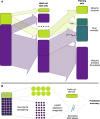Optimal strategies for learning multi-ancestry polygenic scores vary across traits
- PMID: 37419925
- PMCID: PMC10328935
- DOI: 10.1038/s41467-023-38930-7
Optimal strategies for learning multi-ancestry polygenic scores vary across traits
Abstract
Polygenic scores (PGSs) are individual-level measures that aggregate the genome-wide genetic predisposition to a given trait. As PGS have predominantly been developed using European-ancestry samples, trait prediction using such European ancestry-derived PGS is less accurate in non-European ancestry individuals. Although there has been recent progress in combining multiple PGS trained on distinct populations, the problem of how to maximize performance given a multiple-ancestry cohort is largely unexplored. Here, we investigate the effect of sample size and ancestry composition on PGS performance for fifteen traits in UK Biobank. For some traits, PGS estimated using a relatively small African-ancestry training set outperformed, on an African-ancestry test set, PGS estimated using a much larger European-ancestry only training set. We observe similar, but not identical, results when considering other minority-ancestry groups within UK Biobank. Our results emphasise the importance of targeted data collection from underrepresented groups in order to address existing disparities in PGS performance.
© 2023. The Author(s).
Conflict of interest statement
G.M. is a director of and shareholder in Genomics PLC, and is a partner in Peptide Groove LLP. M.M. is a Programme Lead for the Diverse Data initiative at Genomics England Ltd. B.L. and C.H. declare no competing interests.
Figures






Similar articles
-
Portability of 245 polygenic scores when derived from the UK Biobank and applied to 9 ancestry groups from the same cohort.Am J Hum Genet. 2022 Jan 6;109(1):12-23. doi: 10.1016/j.ajhg.2021.11.008. Am J Hum Genet. 2022. PMID: 34995502 Free PMC article.
-
Power of inclusion: Enhancing polygenic prediction with admixed individuals.Am J Hum Genet. 2023 Nov 2;110(11):1888-1902. doi: 10.1016/j.ajhg.2023.09.013. Epub 2023 Oct 27. Am J Hum Genet. 2023. PMID: 37890495 Free PMC article.
-
Comparison of methods for building polygenic scores for diverse populations.HGG Adv. 2025 Jan 9;6(1):100355. doi: 10.1016/j.xhgg.2024.100355. Epub 2024 Sep 25. HGG Adv. 2025. PMID: 39323095 Free PMC article.
-
Genetic prediction of complex traits with polygenic scores: a statistical review.Trends Genet. 2021 Nov;37(11):995-1011. doi: 10.1016/j.tig.2021.06.004. Epub 2021 Jul 6. Trends Genet. 2021. PMID: 34243982 Free PMC article. Review.
-
Polygenic Scores for ADHD: A Meta-Analysis.Res Child Adolesc Psychopathol. 2021 Mar;49(3):297-310. doi: 10.1007/s10802-021-00774-4. Epub 2021 Jan 25. Res Child Adolesc Psychopathol. 2021. PMID: 33492530 Review.
Cited by
-
Clinical use of polygenic scores in type 2 diabetes: challenges and possibilities.Diabetologia. 2025 Jul;68(7):1361-1374. doi: 10.1007/s00125-025-06419-1. Epub 2025 Apr 5. Diabetologia. 2025. PMID: 40186687 Free PMC article. Review.
-
Unsupervised Ensemble Learning for Efficient Integration of Pre-trained Polygenic Risk Scores.Res Sq [Preprint]. 2025 Apr 1:rs.3.rs-5976048. doi: 10.21203/rs.3.rs-5976048/v1. Res Sq. 2025. PMID: 40235488 Free PMC article. Preprint.
-
Benchmarking multi-ancestry prostate cancer polygenic risk scores in a real-world cohort.PLoS Comput Biol. 2024 Apr 10;20(4):e1011990. doi: 10.1371/journal.pcbi.1011990. eCollection 2024 Apr. PLoS Comput Biol. 2024. PMID: 38598551 Free PMC article.
-
Polygenic prediction across populations is influenced by ancestry, genetic architecture, and methodology.Cell Genom. 2023 Sep 14;3(10):100408. doi: 10.1016/j.xgen.2023.100408. eCollection 2023 Oct 11. Cell Genom. 2023. PMID: 37868036 Free PMC article.
-
All of Us diversity and scale improve polygenic prediction contextually with greatest improvements for under-represented populations.bioRxiv [Preprint]. 2025 May 8:2024.08.06.606846. doi: 10.1101/2024.08.06.606846. bioRxiv. 2025. PMID: 39149254 Free PMC article. Preprint.
References
Publication types
MeSH terms
Grants and funding
LinkOut - more resources
Full Text Sources
Research Materials

